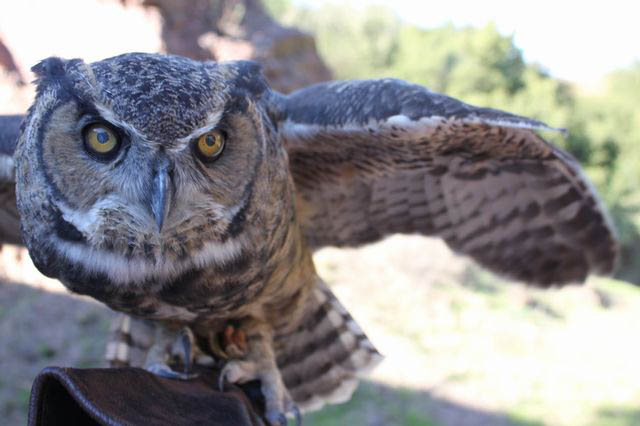Simone Enderlin (’13) and Helena Kleiner (’13) do not play soccer after school or go home to do math problems or surf Facebook. Instead, they hold raptors.
The two Urban School sophomores volunteer at the Randall Museum, a free museum located in Corona Heights in San Francisco that educates kids about wildlife. After attending summer camp at the museum when she was seven, Enderlin wanted to get involved with the animals, all of which are California natives. Kleiner came to the museum because she lives nearby and has been interested in animals her whole life.
A typical Wednesday or Thursday afternoon for these students at the Randall Museum consists of cleaning the cages and exhibits of rodents, newts, turtles, and the water-dwellers of the marine tank, Enderlin’s favorite animals to feed.
The bird cage is elevated about seven feet above the ground, so to feed or hold the birds, Enderlin and Kleiner must climb a ladder. They bring the birds a dinner comprised of five dead mice from a lab in Palo Alto, accompanied by frogs and crickets.
When Enderlin gets to the top, she begins conversing with the raptors, otherwise known as birds of prey.
“’Hey, what’s up, guys?’” goes a typical conversation between Enderlin and the cage’s inhabitants. “‘What it do, Betty?’” Betty is a Harris’ hawk, living alongside Weecha, a blind great-horned owl. Both of these birds, along with crows, ravens, and falcons, are examples of raptors.
During the day, the birds are tied down to perches and the cage doors are open. The girls’ job is to release them and close the cages for the night. This entails untying the leather jesses (straps) and taking out a metal piece called the swivel from around the birds’ talons.
Before being allowed to handle the raptors, Enderlin and Kleiner leaned how to tie knots and how to act around the birds. “It’s not like Hogwarts or anything,” Enderlin said, referring to the Harry Potter school where falconry is a required subject. She hopes to get a pink falconer’s glove.
“Raptors are really intelligent and know who you are,” said Kleiner. “They all have different personalities. With the ravens and crows, you can tell which one is calling.”
But handling the raptors can be nerve-wracking. “Weecha flaps around when reacting to noises. Wings go in your face,” said Enderlin. “One bird is kind of mental and falls off your arm. I don’t like him.” It also takes brute arm strength: “If you have a big bird, your arm gets really tired.”
Students must work at the Randall for a year before holding the raptors. “You can’t just go in there with those big birds because they will rip your face off,” Enderlin advised. “I’ve never been more intimidated, not even – who’s a really intimidating teacher at Urban? – (than) by a hawk.”
Students who are interested in working at the Randall Museum should enroll in the October training class. Those who complete the class can apply to be volunteers. But beware: participants are given a pet mealworm that grows into a beetle. “The object is to not kill your beetle,” said Enderlin. “I did not kill mine.”
She and Kleiner have been doing so for more than two years. Although most of the species at the museum are injured rather than rare, Kleiner does think about conservation. “The Randall Museum is really important because it educates kids about the native species,” she said, adding that it is “important to promote natural habitats, … to educate people about what you want to protect and … (to) give them more space.”
Kleiner makes clear that the museum is not a petting zoo. “There are wild animals in San Francisco and you have to be aware of that. They aren’t dogs or pets,” she said.
If the weather is nice, Kleiner and Enderlin take the birds outside to show young visitors. “Kids will get interested and I have to tell them to step back and not touch the birds so that they won’t get bitten,” says Enderlin.
But working with the raptors is worth it. “It’s a good job,” says Enderlin. “I like the people that work there. Maybe I could get paid. For now I like it.” Enderlin is considering volunteering at the Randall Museum for her junior service project next year.


